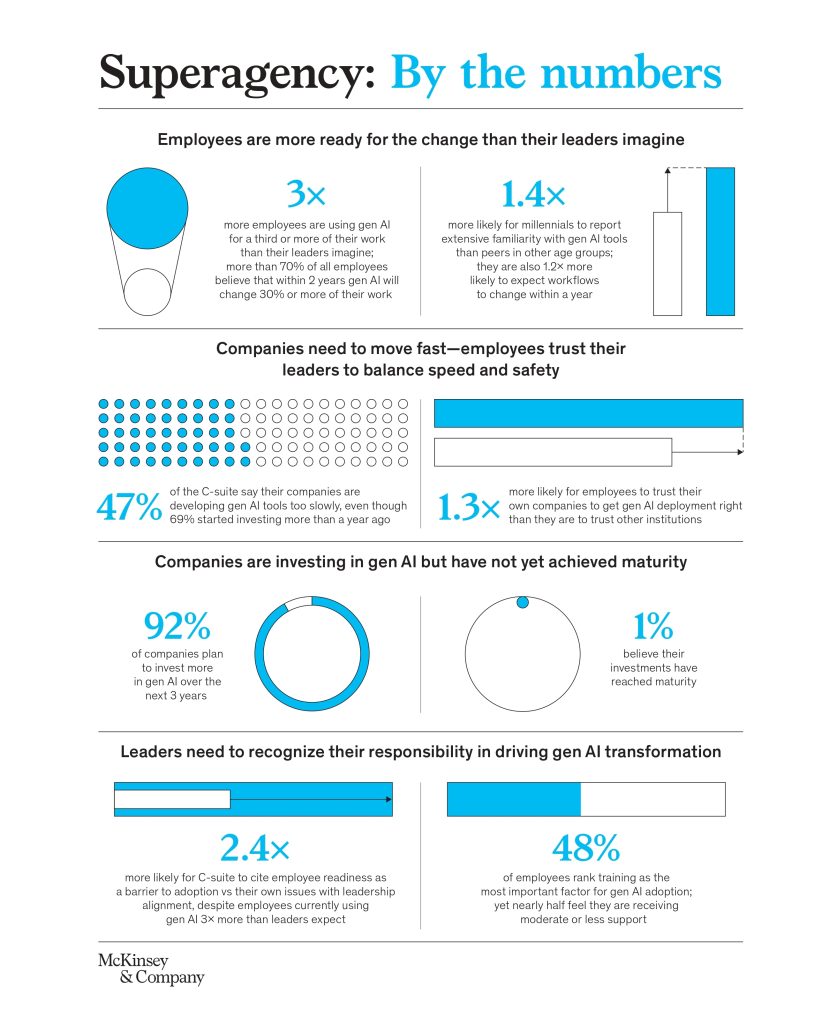
Imagine a world where software anticipates your needs, automates complex tasks, and unlocks unprecedented levels of efficiency. This is the promise of AI-driven software, and it’s rapidly changing the business landscape.
AI adoption is reshaping industries, offering businesses new opportunities to streamline operations, enhance decision-making, and unlock competitive advantages. However, the path to AI integration comes with challenges, including ethical considerations, explainability, and adapting AI-driven solutions to specific business needs.
The Market Structure of AI-Driven Software
The AI market can be divided into two main categories:
- Foundational Models – Large tech firms such as OpenAI, Google, Microsoft, and Amazon dominate this space, given the high cost of training large-scale models. The limited supply of compute resources and expertise creates significant barriers to entry, though open-source alternatives are beginning to change the landscape.
- AI-Driven Software – Unlike foundational models, AI-driven software is an open and competitive market where businesses can differentiate their offerings. Companies are incorporating large language models (LLMs) into their solutions, focusing on aspects such as ease of use, industry-specific applications, and ethical AI practices.

Why the AI Market is in Constant Flux
Despite its rapid growth, the AI industry is far from reaching market equilibrium. Several factors drive continuous change:
- Algorithm efficiency – Ongoing research is reducing compute costs, making AI more accessible.
- Talent availability – The AI talent pool remains limited, creating skill gaps for businesses looking to integrate AI.
- Data quality – Companies must balance data availability with ethical considerations, especially in regulated industries like healthcare and finance.
- Regulations – Governments worldwide are enforcing stricter AI policies, impacting the accessibility and deployment of AI solutions.
- AI Perception Gap – Employees use AI 3× more than business leaders estimate, yet many organizations lack a structured AI integration strategy. Businesses that prioritize seamless AI adoption will avoid internal resistance and improve operational efficiency.
AI Adoption Trends and Market Readiness
Recent insights from McKinsey reveal that while AI adoption is accelerating, businesses face critical gaps in readiness and perception. The following infographic illustrates these trends and their implications for AI-driven software adoption:

Competitive Strategies for AI Startups and SMEs
With AI software becoming a staple in modern businesses, differentiation is key. Here are some strategies you can adopt to stay ahead:
1. Leverage Open-Source AI for Cost Efficiency
Using open-source models allows you to reduce development costs and access cutting-edge AI capabilities without building models from scratch. This gives startups and SMEs a competitive edge without the need for massive infrastructure investments. Moreover, flexible, low-switching-cost AI solutions enable businesses to scale quickly without vendor lock-in, allowing easier adoption and transition.
2. Specialize in Niche Markets
Instead of competing directly with tech giants, focus on industry-specific AI applications (e.g., legal AI, healthcare automation, financial analytics). Domain expertise combined with AI capabilities creates a powerful differentiator and helps you deliver tailored solutions to customers.
3. Prioritize Ethical and Transparent AI
Regulatory pressures and consumer demand for ethical AI make transparency, explainability, and fairness critical factors. Ensuring bias reduction, privacy protection, and responsible AI principles builds trust and long-term adoption.
4. Ensure Seamless Ecosystem Integration
AI adoption is not just about the model itself but how well it integrates into your existing workflows. Many leaders underestimate the actual use of AI within their organizations, creating misalignment between strategy and reality. Providing interoperability with enterprise software (ERP, CRM, cloud services, etc.) will enhance user adoption and create a higher switching cost for competitors.
5. Establish Thought Leadership and Trust
Beyond technical capabilities, positioning yourself as a thought leader will attract customers and investors. Publishing research, case studies, and best practices showcases your expertise and credibility in the AI space.
Learn more about the AI market landscape in the Philippines and how it impacts businesses looking to integrate AI-driven solutions.
The PSI Perspective: Your Data, Your AI, Your Way
At Predictive Systems Inc. (PSI), we believe that AI should be built around your business needs. Instead of one-size-fits-all solutions, we advocate for AI that is:
- Secure – Ensuring data protection and compliance.
- Explainable – Providing transparency into AI decision-making.
- Ethical – Aligning with responsible AI principles.
- Customizable – Tailored to industry-specific challenges and workflows.
Final Thoughts: The Future of AI for Businesses
The AI-driven software market presents tremendous opportunities for businesses that strategically position themselves in this evolving landscape. While foundational models are controlled by a few, the broader AI software industry thrives on differentiation, trust, and ethical AI practices.
For startups and SMEs, the key to success lies in leveraging open-source AI, focusing on niche applications, prioritizing transparency, and integrating AI seamlessly into existing business ecosystems. Businesses that embrace low-switching-cost solutions, strong integration strategies, and clear differentiation will lead the next wave of AI adoption.
Ready to unlock the power of AI for your business? Contact us today for a free consultation and discover how we can tailor AI solutions to your specific needs.


